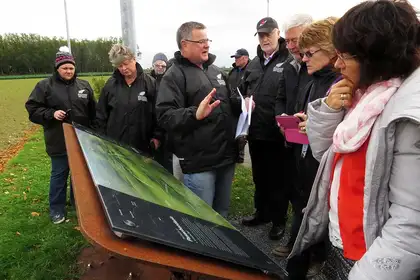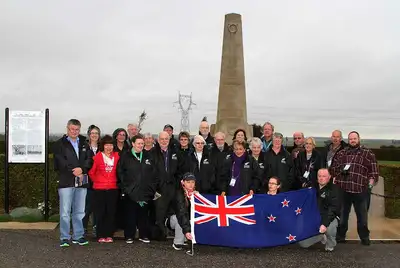
Professor Glyn Harper talking to the tour group at Passchendaele (photo credit/Howard Chamberlain).
Standing on a Western Front battlefield where hundreds of Kiwi soldiers were killed is an emotional experience – especially for an academic deeply acquainted with the statistics, strategies and stories of war.
Passchendaele. Ypres. Arras. Messines. Flanders. Few people understand the significance of these First World War battle sites better than Professor Glyn Harper, eminent war historian and author of more than 30 books, including Massacre at Passchendaele: The New Zealand Story (Harper Collins, 2000).
He is also a sometime historical guide, and shared his knowledge of the stories that accompany the now quiet, still landscapes – once the scene of mass bloodshed, misery and death – with a group of 26 New Zealanders and Australians who he travelled to France and Belgium with for the 100th commemoration events of the Passchendaele battles.
During the eight-day tour last month, Professor Harper gave talks on a range of topics, including New Zealand’s role in the WWI battles of the Somme, Messines and Passchendaele, as well as on the history of the Anzac war memorials and cemeteries in the region.
Highlights of the trip included visiting Passchendaele, one of the deadliest zones of the war where 1179 New Zealanders went missing during the two battles on October 4 and 12 in 1917, and where 450 and 846 were killed respectively, with several hundred dying of their wounds after the battles.
“It's about my fifth time, but it's still a very emotional journey to go there,” he says. “There were tears.”
He and group members, including a woman whose uncle had died there, reflected on the scale of the loss of life, the youth of the dead and wounded soldiers, and the devastating impact these losses had on so many New Zealand families
Around 18,000 New Zealanders died during, or as a result of the First World War, with 2779 killed at Gallipoli and more than 12,000 on the Western Front.

Professor Glyn Harper (left) with the group at Longueval Cemetery (photo credit/Howard Chamberlain).
Battlefield guiding a growing trend
The group also attended New Zealand commemorative events at the Menin Gate, Ypres and at a location called Polygon Wood, as well as a visit to Tyne Cot Cemetery – the largest Commonwealth War Graves Commission cemetery, and with a higher number of New Zealand First World War graves than any other cemetery.
Professor Harper says battlefield guiding is a common activity for established historians in the United Kingdom and the United States, and the trend is growing here too although in a more limited way because of cost. Professor Harper’s travel costs were covered by House of Travel Palmerston North.